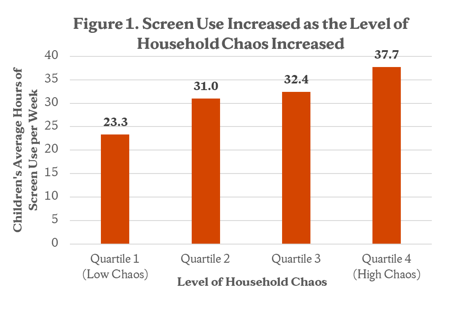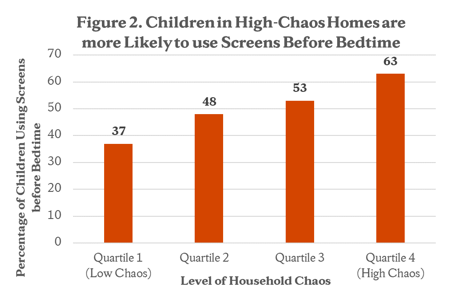Lerner Center for Public Health Promotion and Population Health
Population Health Research Brief Series
Screen Media use is Higher among Preschool Children from More Chaotic Homes
Jennifer A. Emon , Sara E. Benjamin-Neelon
June 2019
Jennifer A. Emon and Sara E. Benjamin-Neelon
DOWNLOAD THE BRIEF [PDF]
View our other research briefs.
KEY FINDINGS
- In this national study of 385 parents, screen media use among preschool-age children was common.
- Watching shows and movies was the most common screen activity, and many children used apps and viewed videos online (e.g., YouTube).
- Children from more chaotic homes used screens more often during the week. Children in the most chaotic homes averaged 14 more hours of screen time per week than children from the least chaotic homes.
- Children from more chaotic homes were more likely to use screens in a way that negatively impacts nighttime sleep.
Early childhood is a critical time for children’s growth and development. Learning how to problem solve, socialize, and regulate emotions are just a few of the skills children develop during these formative years. One factor that may impair healthy development during the preschool years is excessive screen media use. Screen media means watching or engaging with media on an electric screen and includes watching TV, using a computer, smartphone, or touchscreen tablet, or playing videogames.
In the U.S., children under the age of 5 average 2 ½ hours of screen media use per day,1 more than twice the amount recommended by the American Academy of Pediatrics (AAP). High screen use during early childhood has been associated with multiple developmental delays, including language delays and poor cognitive and socio-emotional development. High screen use, screen use before bedtime, and screen use in the bedroom also have negative effects on nighttime sleep quantity and quality among preschool-age children. Screen use can disrupt children’s nighttime sleep, which can result in attentional, learning, and behavioral problems for children.
Children Spend a lot of Time Using Screens
We surveyed 385 parents of 2- to 5-year-old children to assess children’s screen media time use.2 Parents were recruited nationally via social media. The sample included an equal number of boys and girls and was socio-demographically diverse. Screen media use was common among children (Table 1). Nearly all (99.5%) children used some screen media. The most common activity was watching TV shows or movies (84%). Over half of children used apps or watched videos online, using sites such as YouTube. Children averaged 31 hours per week using any screen media, 14.7 hours per week watching shows or movies, 4.8 hours per week using apps, and 5.5 hours per week viewing online videos. Half of children used screens within one hour of going to bed at night, and 41% of children used screens in their bedroom.
Table 1. Nearly all preschool age children (ages 2-5) use screens, and average weekly screen use is high
| % of children with any use | Average weekly screen use hours | |
| Any screen use | 99.5 | 31.0 |
| By screen activity: | ||
| Watching TV shows or movies | 83.6 | 14.7 |
| Using apps | 65.7 | 4.8 |
| Viewing online videos (e.g., YouTube) | 61.3 | 5.5 |
| Video calls (e.g., Facetime, Skype) | 35.6 | 1.2 |
| Listening to streaming music | 26.0 | 2.2 |
| Browsing e-books | 15.8 | 0.9 |
| Playing internet games | 9.9 | 0.8 |
N=385 parents of children ages 2-5
The Role of Household Chaos on Screen Time Use

Household chaos is a measure of disorder and disruption in the home.3 Chaos includes high levels of noise, crowding, and traffic. Similar to children’s screen use, greater levels of chaos in the home is related to more behavioral, attentional, learning, and sleep problems in children.
In our study, we asked parents about the frequency of chaos like noise, rushing, and running late. We found that greater levels of household chaos were related to more screen use among children (Figure 1). Children’s screen use increased as the level of household chaos increased. Children in the most chaotic homes (Quartile 4) averaged 14 more hours per week of screen use than children from the least chaotic homes (Quartile 1).

Higher levels of household chaos were also related to a greater risk of screen use one hour before bedtime (Figure 2). The percentage of children who used screens before bedtime increased as the level of household chaos increased. Nearly two-thirds of children in the most chaotic homes (Quartile 4) used screens before bedtime, compared to 37% of children from the least chaotic homes (Quartile 1). Household chaos was also related to screen use in the bedroom: 54% of children in the most chaotic homes (Quartile 4) used screens before bedtime, compared to 38% of children from the least chaotic homes (Quartile 1).
The underlying reasons for the differences in children’s screen use by household chaos are unclear. It is possible that more chaotic households have limited capacity to monitor and manage children’s screen use in the home or may have other household demands that distract parents from monitoring children’s screen time. More chaotic homes may also be less aware of screen use recommendations for children or of the harms that excessive screen use can have on children. Children in more chaotic homes are at an increased risk of attentional and behavioral problems, and it is possible that adults in more chaotic households are more likely to use screens to occupy or soothe children.4
What can parents do?
We encourage parents and other caregivers to create a media plan that engages preschool-age children. Parents can use stickers to reward their children for following the media rules each day, and parents can also reward their children with activities, such as reading an extra book together or spending extra time playing together before bedtime. Implementing and maintaining a media use plan can be challenging, especially for families with high household chaos. Consistency in enforcing rules is critical, just as when children are potty training or learning to brush their teeth. Parents and other caregivers will need to serve as role models and may need to reduce or modify their own screen use when with their child. While it can be challenging, ensuring young children avoid too much screen use can have lasting benefits for their development and school readiness.
The American Academy of Pediatrics has a wealth of information for parents on age-appropriate screen use for children. Go to healthychildren.org, and click on the link for Family Life and then Media. The AAP also has an interactive, online tool where parents can create a tailored family media plan (HealthyChildren.org/MediaUsePlan). Common Sense Media is also an excellent resource where parents can research the quality of various media content including TV shows, movies, apps, websites, and video games (CommonSenseMedia.org).
Data
We recruited parents of 2-5-year-old children nationally via social media for this cross-sectional study. Parents were able to participant if they had at least one children age 2-5 years old who they lived with at least 50% of the time. Data collection occurred in summer 2017.Of the 519 parents who were eligible for enrollment after completing the screening questionnaire, 479 parents enrolled and 385 parents completed the entire survey. The sample included an equal number of boys and girls and was socio-demographically diverse. Household chaos was measured with a self-reported questionnaire of 15 items that included questions such as We almost always seem to be rushed, You can’t hear yourself think in our home, and No matter how hard we try, we always seem to be running late. A total score is completed from all 15 items, and higher scores reflect more chaotic homes Regression models were adjusted for child age, race, ethnicity and gender; parent age and education level; annual household income; homeownership status; and the number of adults and children under the age of 12 years in the home. Full methodological details are presented in Emond, et al. (2018).2
References
- Rideout V. The Common Sense census: Media use by kids age zero to eight. Common Sense Media. 2017. San Francisco, CA. Available at https://www.commonsensemedia.org/research/the-common-sense-census-media-use-by-kids-age-zero-to-eight-2017. Accessed November 15, 2017.
- Emond JA, Tantum LK, Gilbert-Diamond D, Kim SJ, Lansigan RK, Neelon SB. Household chaos and screen media use among preschool-aged children: a cross-sectional study. BMC Public Health. 2018;18(1):1210.
- Matheny A, Washs T D, Ludwig JL, Philips K. Bringing Order Out of Chaos: Psychometric Characteristics of the Confusion, Hubbub, and Order Scale. J Appl Dev Psychol. 1995;16:429-444.
- Cliff DP, Howard SJ, Radesky JS, McNeill J, Vella SA. Early Childhood Media Exposure and Self-Regulation: Bidirectional Longitudinal Associations. Acad Pediatr. 2018;18(7):813-819.
Acknowledgements
The authors thank all parents who participated in this study. This study was supported by funding from the Dartmouth-Hitchcock Norris Cotton Cancer Center and the National Institute of Diabetes and Digestive and Kidney Diseases of the National Institutes of Health (K01DK117971).
About the Author
Jennifer A. Emond is an assistant professor of biomedical data science and pediatrics at the Geisel School of Medicine at Dartmouth College in Hanover, NH (Jennifer.A.Emond@dartmouth.edu). Sara E. Benjamin-Neelon is an associate professor in the Department of Health, Behavior and Society at Johns Hopkins Bloomberg School of Public Health and Director of the Lerner Center for Public Health Promotion at Johns Hopkins (Sara.Neelon@jhu.edu).